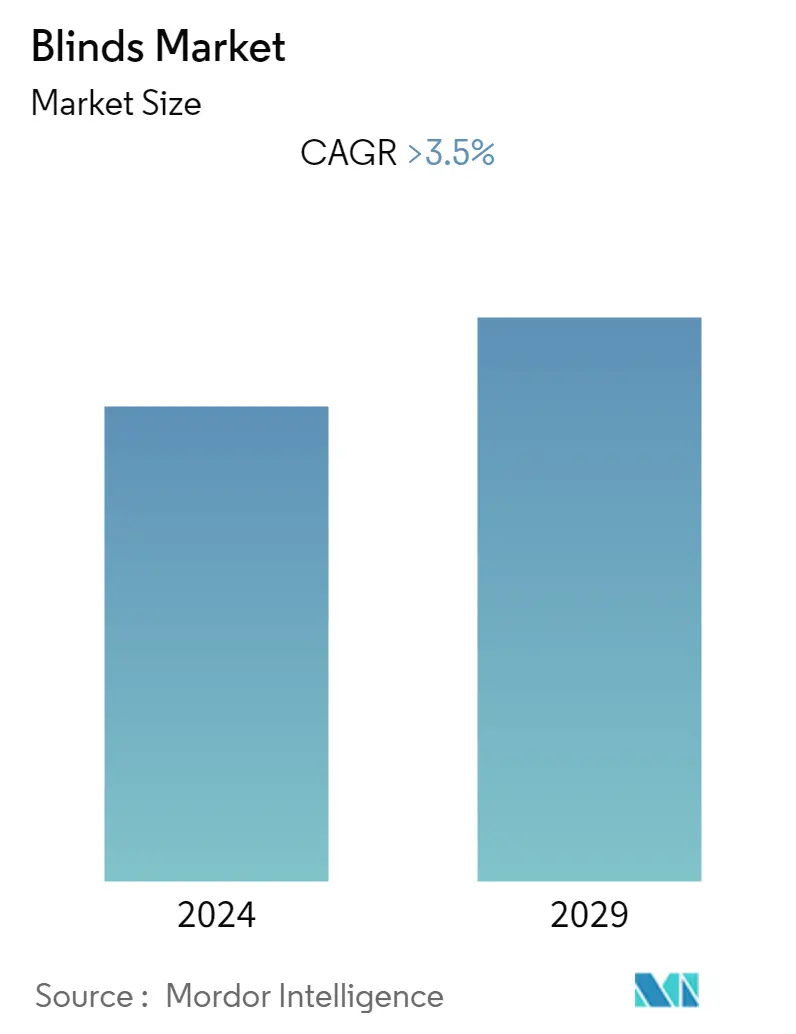Market Size of Blinds Industry

| Study Period | 2020 - 2029 |
| Base Year For Estimation | 2023 |
| CAGR | > 3.50 % |
| Fastest Growing Market | Asia Pacific |
| Largest Market | North America |
| Market Concentration | Medium |
Major Players
*Disclaimer: Major Players sorted in no particular order |
Blinds Market Analysis
The blinds market is expected to register a CAGR of more than 3.5% during the forecast period of 2021-2026. The outbreak of the coronavirus disease (COVID-19) acted as a massive restraint on the blinds manufacturing market in 2020, as supply chains were disrupted due to trade restrictions and consumption declined due to lockdowns imposed by governments globally. Steps by national governments to contain the transmission have resulted in the halting of manufacturing activities and a decline in economic activity with countries entering a state of lockdown, and the outbreak was expected to continue to have a negative impact on businesses throughout 2020 and into 2021.
The real estate industry has witnessed high growth over the past few years, owing to which the value of residential construction is increasing. As the number of houses increases, the demand for window coverings also increases, which is boosting the demand for window blinds. An increase in the spending of households is also a key factor driving the window blinds market. Blinds are window coverings made up of several long vertical or horizontal slats of various hard materials such as plastic, wood, and metal. These slats are bound together by cords that run through the blind vanes. These vanes or slats tumble down as the blind is lowered or can be pulled to the side of a window to stack lengthwise. These slats or louvers are individually attached together to create a complete blind. They are meant to stay tightly closed for light control and privacy and can be tilted or adjusted at different angles to limit the light from entering. Key parameters for selecting window blinds include material, quality, and cost. The rise in commercial and residential development drives the window blinds market. The window blinds market is anticipated to expand at a considerable pace soon. The increase in popularity of smart homes and the rise in infrastructural development around the world are key factors that are expected to drive the market during the forecast period. Additionally, change in the interior design of residential and commercial spaces is also boosting the window blinds market. Commercial spaces are increasing in number, and these are closely maintaining their ambiance preference. Many office spaces maintain an office ambiance as they try to bring out their business strategies with employee health, performance, and wellness. The middle-class population prefers conventional curtains to cover windows over blinds due to the low prices of curtains. This is likely to restrain the window blinds market.
The window blinds market is witnessing an upsurge because of new innovations and developments in technology, which attracts many users to these products. Key players operating in the window blinds market are giving prime importance to adding innovative blinds to their product portfolios by carrying manufacturing advancements in technology and introducing product lines. Technological advancements available in the window blinds market include the use of remote control to lower or raise blinds. Moreover, automated blinds are available in cordless blinds, which can be easily handled. Smart blinds are the latest technology available in the market. These blinds can be controlled using mobile devices.
Blinds Industry Segmentation
Blinds are window coverings made up of several long vertical or horizontal slats of various hard materials such as plastic, wood, and metal. A complete background analysis of the global blinds market, which includes an assessment of the blinds market, emerging trends by segments and regional markets, significant changes in market dynamics, and market overview, is covered in the report. The report also features qualitative and quantitative assessments by analyzing the data gathered from industry analysts and market participants across key points in the industry's value chain. The blinds market is segmented by product type (roller blinds, panel blinds, pleated blinds, roman blinds, vertical blinds, wood blinds, faux wood blinds, and aluminum blinds), material type (metal blinds, plastic blinds, synthetic blinds, and other material types), operation type (manual window blinds and electric window blinds [automated]), end user (residential and commercial), distribution channel (distributors/wholesalers, retailers, commercial sales, and online stores), and geography (North America, Europe, Asia-Pacific, South America, and Middle-East and Africa).
| Product Type | |
| Roller Blinds | |
| Panel Blinds | |
| Pleated Blinds | |
| Roman Blinds | |
| Vertical Blinds | |
| Wood Blinds | |
| Faux Wood Blinds | |
| Aluminum Blinds |
| Material Type | |
| Metal Blinds | |
| Plastic Blinds | |
| Synthetic Blinds | |
| Other Material Types |
| Operation Type | |
| Manual Window Blinds | |
| Electric Window Blinds (Automated) |
| End User | |
| Residential | |
| Commercial |
| Distribution Channel | |
| Distributors/Wholesalers | |
| Retailers | |
| Commercial Sales | |
| Online Stores |
| Geography | |
| North America | |
| Europe | |
| Asia-Pacific | |
| South America | |
| Middle-East and Africa |
Blinds Market Size Summary
The blinds market is poised for significant growth, driven by the expansion of the real estate sector and increasing household spending. As residential construction rises, so does the demand for window coverings, including blinds, which are made from materials such as plastic, wood, and metal. These products offer light control and privacy through adjustable slats. The market is further bolstered by the trend towards smart homes and infrastructural development, with innovations like remote-controlled and automated blinds gaining popularity. However, the preference for conventional curtains among the middle-class due to cost considerations poses a challenge to market growth.
The market landscape is characterized by rapid urbanization and a growing middle-class population, particularly in the Asia-Pacific region, which is experiencing the fastest growth. Technological advancements and product innovations are enabling both large and mid-size to smaller companies to expand their market presence. Key players like Hunter Douglas and Springs Window Fashions are actively enhancing their product portfolios through strategic acquisitions and technological advancements. The demand for blinds is also fueled by residential remodeling projects, as homeowners seek to replace older blinds with newer, more functional options.
Blinds Market Size - Table of Contents
-
1. MARKET INSIGHTS AND DYNAMICS
-
1.1 Market Overview
-
1.2 Market Drivers
-
1.3 Market Restraints
-
1.4 Value Chain/Supply Chain Analysis
-
1.5 Porter's Five Forces Analysis
-
1.5.1 Threat of New Entrants
-
1.5.2 Bargaining Power of Buyers/Consumers
-
1.5.3 Bargaining Power of Suppliers
-
1.5.4 Threat of Substitute Products
-
1.5.5 Intensity of Competitive Rivalry
-
-
1.6 Impact of COVID-19 on the Market
-
-
2. MARKET SEGMENTATION
-
2.1 Product Type
-
2.1.1 Roller Blinds
-
2.1.2 Panel Blinds
-
2.1.3 Pleated Blinds
-
2.1.4 Roman Blinds
-
2.1.5 Vertical Blinds
-
2.1.6 Wood Blinds
-
2.1.7 Faux Wood Blinds
-
2.1.8 Aluminum Blinds
-
-
2.2 Material Type
-
2.2.1 Metal Blinds
-
2.2.2 Plastic Blinds
-
2.2.3 Synthetic Blinds
-
2.2.4 Other Material Types
-
-
2.3 Operation Type
-
2.3.1 Manual Window Blinds
-
2.3.2 Electric Window Blinds (Automated)
-
-
2.4 End User
-
2.4.1 Residential
-
2.4.2 Commercial
-
-
2.5 Distribution Channel
-
2.5.1 Distributors/Wholesalers
-
2.5.2 Retailers
-
2.5.3 Commercial Sales
-
2.5.4 Online Stores
-
-
2.6 Geography
-
2.6.1 North America
-
2.6.2 Europe
-
2.6.3 Asia-Pacific
-
2.6.4 South America
-
2.6.5 Middle-East and Africa
-
-
Blinds Market Size FAQs
What is the current Blinds Market size?
The Blinds Market is projected to register a CAGR of greater than 3.5% during the forecast period (2024-2029)
Who are the key players in Blinds Market?
Hunter Douglas, Springs Window Fashions, Hillarys, Aspect Blinds and Aluvert Blinds are the major companies operating in the Blinds Market.

